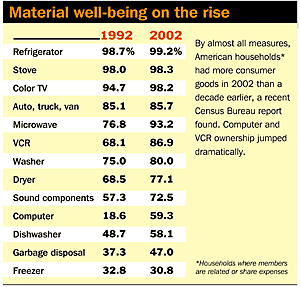
Sure, there are still poor, and we were supposedly seeing them in New Orleans after the flood. However, just how poor is open to question.
By Mark Trumbull | Staff writer of The Christian Science Monitor.
In case there was any doubt, a study has confirmed that Americans have a lot of what economists know, technically, as stuff.
These census findings, released earlier this month, were true even before gifts piled up under trees this past week.
The bottom 10 percent of the income ladder averaged just (my comment JUST?) 0.6 cars per household in 2002, the same as 1992.
Still, by almost all measures, the data show rising well-being for all of society. And while the wealth gap may not be narrowing, the rich-poor gap in lifestyles has narrowed substantially since 1992 when measured in many of these tangible items.
... the conveniences they (those in poverty) have are in fact pretty good."
Census researchers don't have a happiness index, but they are exploring aspects of well-being that go beyond physical goods. For example, nearly 13 percent of Americans have incomes that place them below the official poverty line. But what does that mean in terms of their daily lives? The fact that 95 percent of them may have a refrigerator tells only part of the story.
The Census report also compares, from 1992 through 1998, people's perceptions of whether basic needs were being met. More than 92 percent of Americans below the poverty line said they had enough food, as of 1998. Some 86 percent said they had no unmet need for a doctor, 89 percent had no roof leaks, and 87 percent said they had no unpaid rent or mortgage.
While some improvement was found in all those measures over that period, shortfalls obviously remain. But in many goods, the progress is significant for poor and rich alike.
Two-thirds of those in poverty had air conditioners in 1998, up from 50 percent in 1992. Personal computers have grown increasingly ubiquitous. Where fewer than 20 percent of homes had them in 1992, nearly 60 percent did in 2002 (more than own dishwashers).
Even with the rise interactive tools like computers and media players - alas, Apple iPods aren't included in the Census survey yet - the preferred appliance of couch potatoes is also spreading. There are now 2.1 TV sets per household, up from 1.6 in 1992.
The Census report doesn't measure environmental factors. The US routinely consumes more resources per capita than most other nations.
(Illustration)
Some of the very poorest are the folks who are the streets because of substance abuse, psychological problems, or temporarty displacements. There is also new arrivals that add to that group, many of whom will be very upwardly mobile in the short term.
For the rest of the article
No comments:
Post a Comment